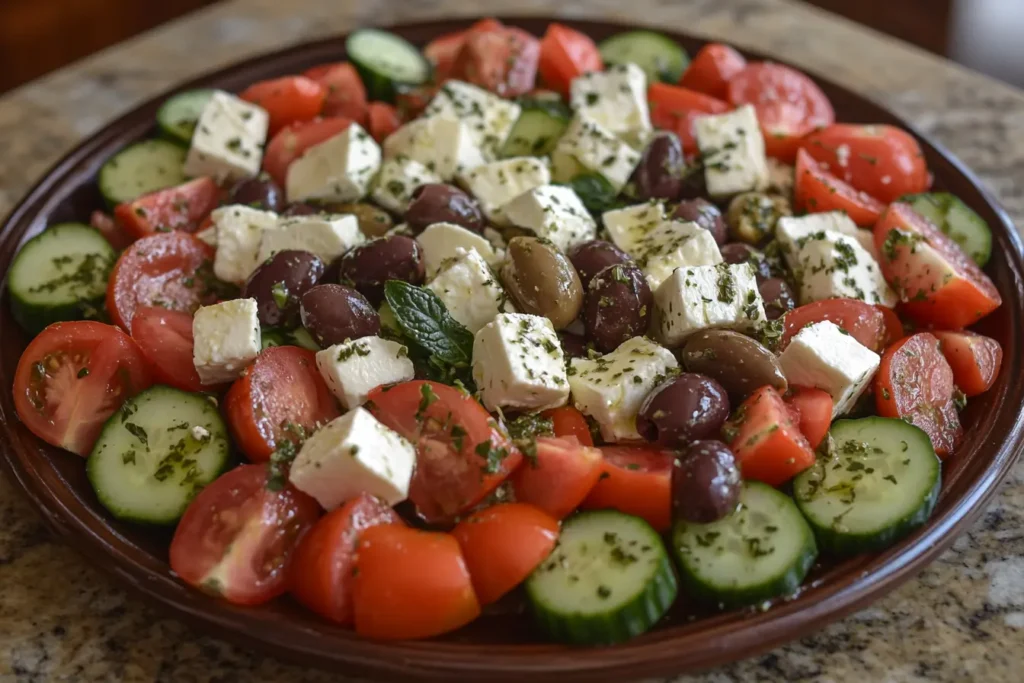I remember my grandmother’s kitchen, always filled with the fragrant aroma of lemon, oregano, and garlic. Those smells instantly transport me back to my childhood summers in Greece. Sun-ripened tomatoes, fresh-picked herbs, and the tang of feta cheese filled our meals. It’s no wonder I fell in love with cooking!
I want to share that love with you by exploring what are the most popular Greek ingredients. These ingredients are the heart and soul of Greek cuisine. They’re the foundation of countless delicious and healthy dishes, from simple salads to elaborate feasts. Learning about these key components will open up a world of flavor and help you understand what gives Greek food its distinctive Mediterranean character.

The Foundation of Flavor: Essential Greek Ingredients
Olive Oil: The Liquid Gold
Olive oil is the cornerstone of Greek cooking. I use it in almost everything! It’s not just for salads and dips. I drizzle it over grilled meats, roasted vegetables, and even use it in baking. Look for extra virgin olive oil, which has the best flavor and health benefits. A good quality olive oil will have a fruity, peppery taste. Don’t be afraid to spend a little more – it makes all the difference!
Fresh Herbs and Spices: A Symphony of Aromas
Fresh herbs and spices bring Greek food to life. Oregano, mint, dill, and parsley are some of my favorites. I love adding them to salads, marinades, and sauces. Dried herbs are convenient, but fresh herbs have a brighter, more intense flavor. If you’re using dried, remember that a little goes a long way. A pinch of dried oregano equals about a tablespoon of fresh.
Lemons: A Burst of Sunshine
Lemons are another essential ingredient. I use both the juice and the zest to add a vibrant, citrusy kick. Lemon juice brightens up salads, sauces, and marinades. Lemon zest adds a wonderful aroma and flavor to baked goods and roasted meats. Preserved lemons, which are lemons packed in salt, are a unique ingredient that add a salty, tangy flavor to stews and tagines.
From the Garden: Vibrant Vegetables
Tomatoes: The Heart of Greek Cooking
Tomatoes are a staple in Greek ingredients cuisine. I use them in everything from fresh salads to hearty stews. Ripe, juicy tomatoes are delicious on their own, simply sliced with a drizzle of olive oil and a sprinkle of salt. Sun-dried tomatoes add a concentrated, intense flavor to sauces and pasta dishes. Tomato paste is a pantry essential, forming the base of many rich and flavorful sauces.
Cucumbers, Onions, and Garlic: The Supporting Greek ingredients Cast
Cucumbers, onions, and garlic are the unsung heroes of Greek ingredients cooking. They add flavor and texture to countless dishes. I love the refreshing crunch of cucumbers in a classic Greek salad. Onions add a savory depth to stews and sauces. Garlic, with its pungent aroma and flavor, is essential in marinades, dips, and roasted vegetables.

Eggplant and Zucchini: Versatile Stars
Eggplant and zucchini are incredibly versatile. I love grilling thick slices of eggplant and zucchini, then marinating them in a lemon-herb dressing. Eggplant is also the star of Moussaka, a layered casserole with ground meat and a creamy béchamel sauce. Zucchini blossoms, delicate and flavorful, are often stuffed with rice and herbs.
Leafy Greens: A Touch of Freshness
Leafy greens like spinach, chard, and dandelion greens add a healthy and refreshing touch to Greek Greek ingredients dishes. I use them in salads, pies, and stews. Spinach and feta cheese make a classic filling for Spanakopita, a savory pastry wrapped in flaky phyllo dough. Leafy greens also add a boost of nutrients to hearty bean stews.

Protein Powerhouses: Meat, Seafood, and Cheese
Lamb and Beef: Traditional Favorites
Lamb and beef are popular choices for hearty Greek ingredients meals. I love slow-roasting lamb with garlic and herbs until it’s fall-apart tender. Souvlaki, grilled skewers of marinated lamb or beef, is a classic street food. Beef stifado, a rich stew with onions and cinnamon, is perfect for a chilly evening. Ground lamb or beef is often used in moussaka and stuffed vegetables.
Fresh Seafood: Treasures of the Sea
With its long coastline, Greece offers an abundance of fresh seafood. I love grilling whole fish with lemon and herbs, keeping it simple to let the natural flavors shine through. Fried calamari, crispy and golden, is a popular appetizer. Octopus, grilled or marinated, is a delicacy. Shrimp and mussels often appear in flavorful seafood stews.
Feta and Yogurt: Creamy Delights
Feta cheese and Greek yogurt are essential in Greek ingredients cuisine. I crumble feta over salads, bake it in pastries, and use it as a stuffing for vegetables. Its salty, tangy flavor pairs beautifully with fresh vegetables and herbs. Greek yogurt, thick and creamy, is a versatile ingredient. I use it in dips, sauces, and marinades. It adds a tangy creaminess to tzatziki, a refreshing cucumber-yogurt dip. I even enjoy it as a healthy breakfast with honey and nuts, or as a base for creamy desserts.
Pantry Staples: Grains and Legumes
Rice and Orzo: Grain Essentials
Rice and orzo are essential pantry staples in Greek cooking. I often serve fluffy rice as a simple side dish, soaking up the delicious flavors of sauces and stews. Orzo, a small, rice-shaped pasta, is perfect in soups and salads. I also use orzo in baked dishes, like Giouvetsi, a comforting casserole with chicken or lamb.
Chickpeas and Lentils: Hearty Legumes
Chickpeas and lentils are healthy and hearty Greek ingredients. They’re packed with protein and fiber. I love adding chickpeas to salads for extra texture and flavor. Lentil soup, a comforting and nutritious meal, is a staple in many Greek homes. I also use chickpeas to make creamy hummus, a popular dip served with pita bread and vegetables.
Phyllo Dough: Flaky and Versatile
Phyllo dough, paper-thin sheets of pastry, is the key to some of the most iconic Greek ingredients. I use it to create delicate, flaky pastries filled with savory or sweet ingredients. Spanakopita, a spinach and feta pie, is a classic example. The crispy layers of phyllo perfectly complement the savory filling. Baklava, a decadent dessert made with layers of phyllo, nuts, and honey syrup, is another beloved treat. Working with phyllo can be a bit challenging, but the results are definitely worth it!
FAQ
What are popular Greek ingredients?
Popular Greek ingredients include olive oil, fresh herbs like oregano and mint, lemons, a variety of vegetables like tomatoes, cucumbers, and eggplant, cheeses like feta, and proteins such as lamb, fish, and chickpeas. These greek ingredients form the base of many classic Greek dishes.
What gives Greek food its signature flavor?
The signature flavor of Greek food comes from the combination of fresh, high-quality ingredients, fragrant herbs and spices, and simple cooking techniques that allow the natural flavors to shine through. It’s a harmonious blend of bright, savory, and tangy notes.
What is the main ingredient found in almost every dish in Greece?
Olive oil is the undisputed king of Greek cuisine. I use it in almost every dish, from salads and dips to roasted meats and vegetables. Its rich flavor and health benefits are essential to Greek cooking.
What are the most popular Greek spices?
The most popular Greek spices include oregano, a staple in many dishes, mint, often used in salads and sauces, dill, which pairs well with fish and vegetables, bay leaves, which add depth to stews and soups, and cinnamon, often used in both sweet and savory dishes.
Putting it All Together: Creating Your Greek Feast
Now that you know the key Greek ingredients, it’s time to get creative! Don’t be afraid to experiment and find your favorite flavor combinations. Start with a simple Greek salad: juicy tomatoes, crisp cucumbers, crunchy onions, salty feta, and a generous drizzle of olive oil. Add grilled chicken or fish for a complete meal. Try making a hearty lentil soup with crusty bread. Or, if you’re feeling adventurous, tackle a classic dish like Moussaka or Spanakopita.
My twin daughters, Lily and Mia, love helping me in the kitchen, especially when we’re making Greek salad. They’re in charge of tearing the lettuce and adding the cucumbers. It’s a simple dish, but it’s packed with flavor and healthy ingredients. Plus, it’s a fun way to spend time together and share our love of Greek food. So gather your ingredients, put on some Greek music, and enjoy the journey of creating your own delicious Greek feast!

